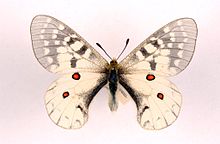Parnassius clodius
| Parnassius clodius | ||||||||||||
|---|---|---|---|---|---|---|---|---|---|---|---|---|

Parnassius clodius , female |
||||||||||||
| Systematics | ||||||||||||
|
||||||||||||
| Scientific name | ||||||||||||
| Parnassius clodius | ||||||||||||
| Ménétriés , 1855 |
Parnassius clodius is a butterfly ( butterfly ) in the family of the knight butterfly (Papilionidae).
features
butterfly
The wingspan of the moth is 50 to 62 millimeters. The basic color of all wings is white. On top of the front wings , several tie-like, blackish, but no red spots stand out. The submarginal region is very thinly scaled and translucent glass. There are usually two red, black-rimmed eye-spots on the hind wings . Overall, the females have a more contrasting and darker coloration than the males, especially the specimens from Alaska . The undersides of the wings are essentially the same color as the upper sides, but are a little paler. All drawing elements can vary in their intensity depending on the geographic region or the respective altitude of the occurrence. Mated females have a sphragis made of chitin on their abdomen . The antennae are monochrome black and not ringed in both sexes.
Caterpillar
Adult caterpillars are black to black-brown in color. Yellow dots, which are present on each segment, stand out conspicuously. The body is also covered with short, thin hair.
Similar species
Parnassius eversmanni , also known as Yellow Apollo (Yellow Apollo)in English, differs from Parnassius clodius in that the central red eye-spot on the upper side of the hind wings is usuallyconnected to or at least close tothe darkband that beginsnear the tornus reaches. The males also have a yellowish basic color.
Parnassius phoebus can beeasily distinguishedfrom the two aforementioned species by the antennae, which are ringed alternately in black and white. Some female specimens also show red eye spots on the upper side of the forewing and always have a shovel-shaped extension on the sphragis.
There are no other species that are similar in appearance in North America, which means that there is no danger of confusion for geographical reasons.
distribution and habitat
Parnassius clodius occurs in a strip from Alaska over British Columbia and further south to California . The easternmost extent extends to Wyoming , Idaho and Nevada . Since the species can only be found in North America, it is also known there as the American Apollo . It prefers to colonize open mountain and hilly landscapes.
Way of life
The main flight time for the moths is June and July. They like to visit different flowers to take in nectar. The females scatter the yellow-brown eggs individually, but indiscriminately, near the food plants. The caterpillars feed on the leaves of various fume plants (Fumariaceae), such as the American heart flower ( Dicentra formosa ) and Dicentra pauciflora or Dicentra uniflora . Since the food plants also contain toxins that are stored in caterpillars, pupae and butterflies, the animals are avoided by predators. The moth's red eye-spots serve as an additional warning. Pupation takes place in a cocoon on the ground. The species overwinters as an egg and sometimes remains at higher altitudes for two years.
Subspecies
The following subspecies are mentioned:
- Parnassius clodius altaurus
- Parnassius clodius baldur
- Parnassius clodius claudianus
- Parnassius clodius incredibilis
- Parnassius clodius menetriesii
- Parnassius clodius pseudogallatinus
- Parnassius clodius shepardi
- Parnassius clodius sol
- Parnassius clodius strohbeeni
swell
Individual evidence
- ↑ Butterflies and Moths of North America http://www.butterfliesandmoths.org/species/Parnassius-clodius
- ↑ a b c d James A. Scott: The Butterflies of North America: A Natural History and Field Guide. Stanford, California: Stanford University Press, 1986, ISBN 0-8047-2013-4 , pp. 189/190
- ↑ Distribution http://www.nic.funet.fi/pub/sci/bio/life/insecta/lepidoptera/ditrysia/papilionoidea/papilionidae/parnassiinae/parnassius/index.html#clodius
literature
- James A. Scott: The Butterflies of North America , Stanford University Press, Stanford CA., 1992, ISBN 0-8047-2013-4 , pp. 189/190
Web links
- jeffpippen - photos
- butterfliesofamerica - Butterflies of America
